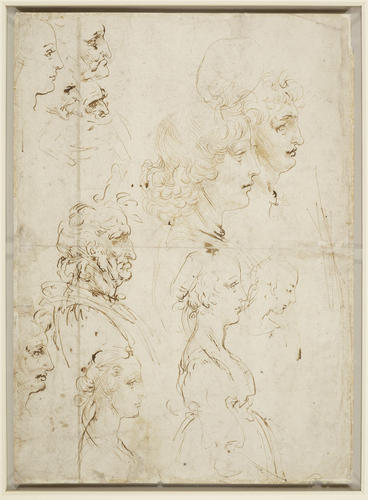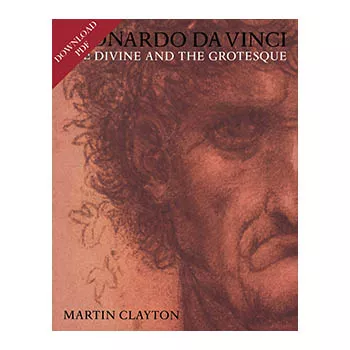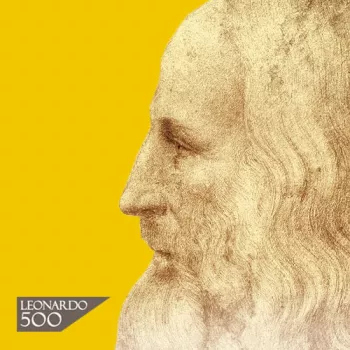The Madonna and Child with the infant Baptist, and heads in profile c.1478-80
Pen and ink | 40.5 x 29.0 cm (sheet of paper) | RCIN 912276

Leonardo da Vinci (1452-1519)
The Madonna and Child with the infant Baptist, and heads in profile c.1478-80

Leonardo da Vinci (1452-1519)
The Madonna and Child with the infant Baptist, and heads in profile c.1478-80



-
Recto: Filling most of the sheet, a large compositional sketch of the Madonna and Child with the infant Baptist, almost certainly the first drawing to be made. The Madonna is kneeling on one leg while twisting to hold the Child, a pose that Leonardo returned to repeatedly during his career (see eg. 912337). Leonardo drew the head of the Madonna in two positions, first looking down at the suckling Child and then, more heavily hatched, gazing sombrely at an indeterminate point between the viewer and the holy group. A few lines indicate a watery landscape with precipitous hills, as seen in many of Leonardo’s paintings. No corresponding painting by Leonardo is known, but several variants by followers may indicate that he worked it up at least as far as a cartoon (eg. a painting attributed to Raffaello Piccinelli, il Brescianino, in the Museo di Capodimonte, Naples, inv. 1870.84138; repr. C. Bambach, Leonardo da Vinci Rediscovered, 2019, I, p. 210). The pyramidal arrangement of the three figures was to be a favourite motif of the artists of the High Renaissance, seen particularly in the Madonnas of Raphael, who was looking closely at the works of Leonardo during his Florentine years (c.1504-8).
Having made this large sketch across the whole of the sheet, Leonardo then added another smaller study of the Baptist at upper right, two sketches of figures in a pose familiar from Roman sarcophagi, with front leg bent and rear leg outstretched, and then covered the two sides of the sheet with twenty-four human heads and three heads of animals. His interest was in the permanent features rather than fleeting emotion, and all but one of the human studies on this sheet show the face in impassive profile. The profile reduces the face to elements that can be manipulated at will, and while it might appear that Leonardo was working on three facial types - young man, young woman, old man - all the profiles here are variants of a standard form. At lower centre, just above the dragon's head, is a pure profile drawn with a mouth but no eye. This is the 'neutral' profile, with no distortions or exaggerations - the archetype of beauty. A couple of the other studies come close to it, such as the carefully finished head of the youth below the Child at centre left, the woman at top left, or the youth at upper centre of the verso. All the other heads are essentially variations on that profile, changing the shape of one or other of the components to observe the effects.
Leonardo was investigating, unsystematically, how subtle variations in the shapes of forehead, nose, mouth and chin affect our perception of the face's age, gender, and beauty. At lower right, for example, the profile progresses through three stages of transformation as the nose become more undulating and the lips more puckered. Just below the centre, an old man with drooping nose and jutting lower lip is contrasted with an infant with turned-up nose and receding lip. The woman at top left is caricatured in another profile, immediately adjacent, in which all her features are swollen somewhat, though she may have changed sex in the process.
The roaring of the lion and dragon at the bottom of the recto have their human counterpart in a sketch towards the upper left of the verso. The lion is little different, except in drawing style, from that on the Anghiari sheet of twenty-five years later, 912326.
*
Verso: Eleven further profiles, including at centre right the 'warrior' type who was to be a constantly recurring motif in Leonardo's art. A very similarly drawn profile appears on a sheet in the Uffizi inscribed by Leonardo with the date 1478, and the present sheet must have been executed at around the same time. He is distorted one stage further in the profile to the right of top left, as the nose descends and the lower lip rises almost to meet it.
Most of these profiles must have been drawn from Leonardo's imagination, though several of the sketches of the young woman show her in contemporary dress and may have been done from the life. Like all artists of his day, Leonardo doubtless used friends, assistants and servants as impromptu models, but here the young woman was no more than raw material for Leonardo's game of profiles, losing any sense of individuality and becoming just a type. When Leonardo looked hard at a model he was capable of great objectivity (see 912505), but here we see how early in his career this one basic profile with its range of variations had become habitual, even deliberately so. It would be possible to rearrange the profiles on this sheet into a gradually evolving sequence, from the ideally beautiful to the ideally ugly, and this locus was to be the basis of all of Leonardo's investigations into the form of the face.
(Text adapted from M. Clayton, The Divine and the Grotesque, London 2002)Provenance
Bequeathed to Francesco Melzi; from whose heirs purchased by Pompeo Leoni, c.1582-90; Thomas Howard, 14th Earl of Arundel, by 1630; probably acquired by Charles II; Royal Collection by 1690
-
Creator(s)
Acquirer(s)
-
Medium and techniques
Pen and ink
Measurements
40.5 x 29.0 cm (sheet of paper)
Markings
watermark: Ladder. Close to Briquet 5911 (Siena, 1476-94) [-, This is an exclusively Italian watermark]
Object type(s)
Other number(s)
RL 12276Alternative title(s)
Recto: The Madonna and Child with the infant Baptist, and heads in profile. Verso: Heads in profile










